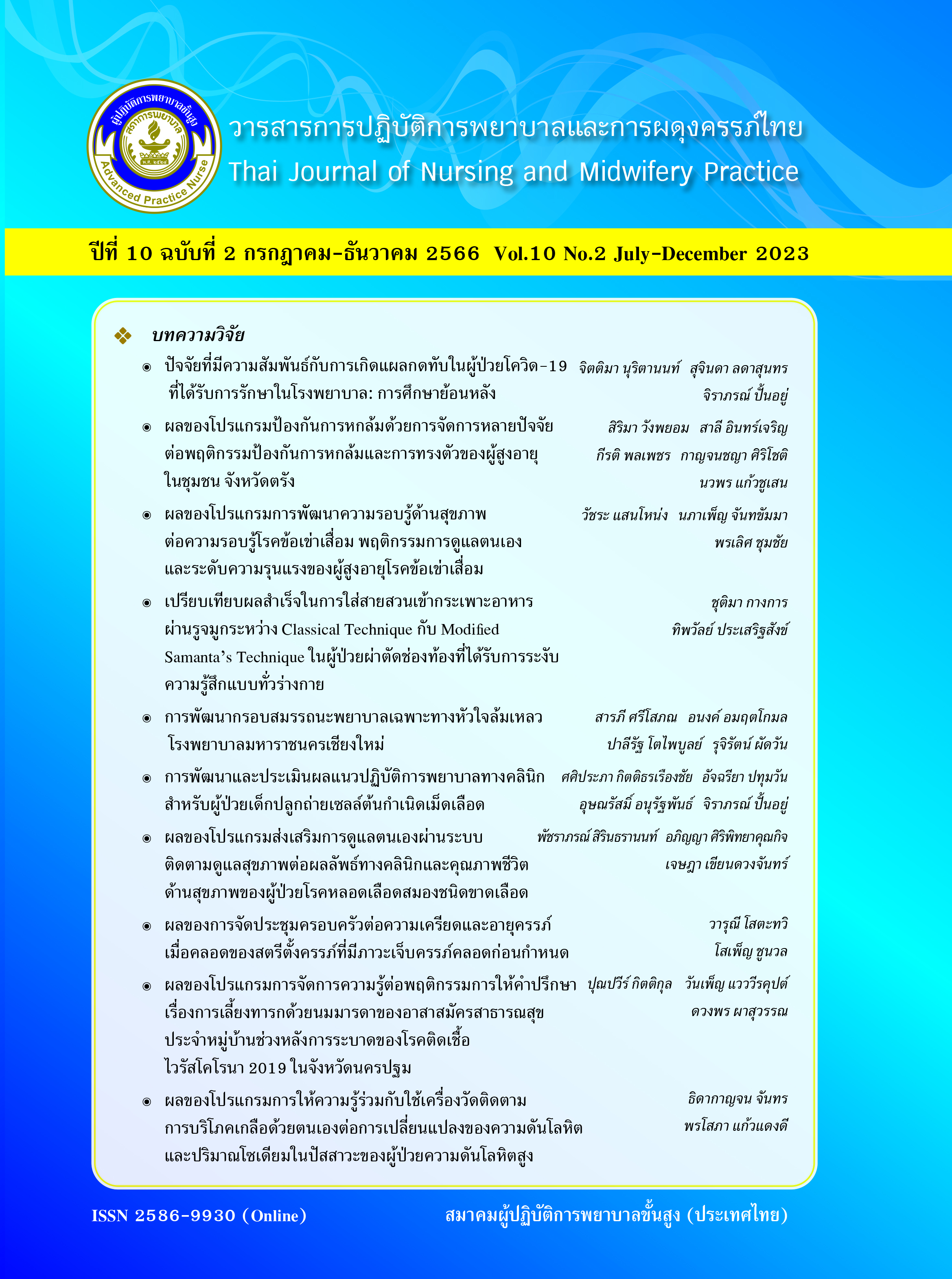Comparison the Success in Inserting a Feeding Tube from Nostril to Stomach between Classical Technique and Modified Samanta’s Technique in Patients Undergoing General Anesthesia for Abdominal Surgery
Main Article Content
Abstract
Abstract: This randomized controlled trial aimed to compare the success in inserting a feeding tube from nostril to stomach between the use of Modified Samanta’s technique (intervention group) and the use of classical technique (control group) in patients with abdominal surgery undergoing general anesthesia. 62 patients selected during December 2020 to December 2021, were randomly allocated by computer, with allocation concealment, to one or other of the two groups. Patients and researcher were blinded to the technique used. A form for recording feeding tube insertion success was assessed using content validity devices. Data were analyzed using descriptive and inferential statistics, namely chi-square, independent t-test, repeated measure ANOVA, logistic regression, survival analysis, log-rank test and Cox proportional hazards model. The result showed no significant difference in the success of insertion between the two groups (p-value = .35). However, the time to completion of the procedure in the intervention group was shorter than that in the control group (difference of means = 18.10s; 95% CI: 4.31, 31.89) at p=.001. There was no difference between groups in bleeding (p=0.15, tube kinking (p=.21), or vital sign change (p>.05). In conclusion, the Modified Samanta’s technique is recommended as a method that is quicker and more efficient for extracting air from the stomach, facilitating faster gas removal. In future studies, several factors should be considered, including sample size and the technique of inserting the nasogastric tube to minimize the risk of bleeding and tube kinking.
Downloads
Article Details

This work is licensed under a Creative Commons Attribution-NonCommercial-NoDerivatives 4.0 International License.
References
Wongyingsinn M. Preanesthetic evaluation and preparation. Essentials in Preoperative Assessment. Bangkok: Department of Anesthesia Faculty of Medicine Siriraj Hospital Mahidol University, 2020. (In Thai)
Wongyingsinn M. Preoperative testing. Essentials in Preoperative Assessment. Bangkok: Department of Anesthesia Faculty of Medicine Siriraj Hospital Mahidol University, 2020. (In Thai)
Pranootnarabhal T, Wongyingsinn M. Smoking cessation. Essentials in Preoperative Assessment. Bangkok: Department of Anesthesia Faculty of Medicine Siriraj Hospital Mahidol University, 2020. (In Thai)
Limratana P. Alcohol and drug abuse. Essentials in Preoperative Assessment. Bangkok: Department of Anesthesia Faculty of Medicine Siriraj Hospital Mahidol University, 2020. (In Thai)
Chaiwat O. Preoperative nutrition management. Essentials in Preoperative Assessment. Bangkok: Department of Anesthesia Faculty of Medicine Siriraj Hospital Mahidol University, 2020. (In Thai)
Wongyingsinn M. Preoperative cardiovascular evaluation for non-cardiac surgery. Essentials in Preoperative Assessment. Bangkok: Department of Anesthesia Faculty of Medicine Siriraj Hospital Mahidol University, 2020. (In Thai)
Piriyapatsom A. Commcon cardiac drugs. Essentials in Preoperative Assessment. Bangkok: Department of Anesthesia Faculty of Medicine Siriraj Hospital Mahidol University, 2020. (In Thai)
Pisitpitayasaree T. Propofol infusion syndrome. Anesthetic Crisis. Bangkok: Department of Anesthesiology Faculty of Medicine Chulalongkorn University, 2020. (In Thai)
Ou GW, Li H, Shao B, Huang LM, Chen GM, Li WC. Comparison of different methods of nasogastric tube insertion in anesthetized and intubated patients. A meta-analysis. World J Clin Cases, 2021; 9 (26): 7772-85.
Kandeel A, Elmorhedi M, Abdalla U. Digital assistance of nasogastric tube insertion in intubated patients under general anesthesia: A single-blinded prospective randomized study. Saudi J Anesth, 2017;11(3):283-6.
Appukutty J, Shroff PP. Nasogastric tube insertion using different techniques in anesthetized patients: a prospective, randomized study. Anesth Analg, 2009;109(3):832-5.
Mandal MC, Dolai S, Ghosh S, Mistri PK, Roy R, Basu SR, et al. Comparison of four techniques of nasogastric tube insertion in anaesthetised, intubated patients: A randomized controlled trial. Indian Journal of Anesthesia, 2014; 58 (6):714-8.
Ghatak T, Samanta S, Baronia AK. A new technique to insert nasogastric tube in an unconscious intubated patient. N Am J Med Sci, 2013; 5 (1):68-70.
Wan Ibadullah WH, Yahya N, Ghazali SS, Kamaruzaman E, Yong LC, Dan A, et al. Comparing insertion characteristics on nasogastric tube placement by using GlideScope™ visualization vs. MacIntosh laryngoscope assistance in anaesthetized and intubated patients. Braz J Anesthesiol, 2016;66(4):363-8.


